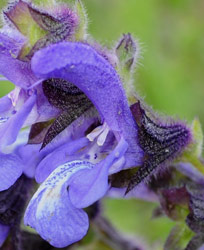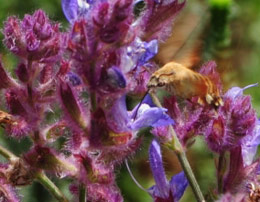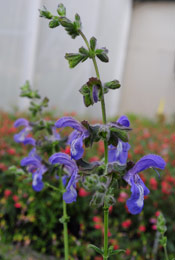Salvia albicaulis
Salvia albicaulis Benth.
Family: Lamiaceae
Common names: white-stemmed sage (Eng.); witstingelsalie (Afr.)
Introduction
A white stemmed shrub for sunny spots, which contrasts well with many other fynbos plants.

Description
Description
Relatively fast growing, Salvia albicaulis is a much branched shrub, 0.5 m or higher. It has an upright, neat habit. Multiple stems grow from a slightly woody rootstock. The stems are noticeably square and have a white appearance, one of the prominent distinguishing characteristics of the species. Fine, short, dense hairs lie flat, covering the stem. No glands are present.

The leaves are simple, fairly thick and have a leathery texture. The shape of the leaves varies from egg-shaped to rounded or spatula-shaped with irregular blunt, rounded projections to sharp-toothed margins. No hairs are present on the top of the leaves but the undersides can have short bristly hairs. The underside of mature leaves appears white with prominent venation.

The inflorescence is branched, producing up to 8 whorls of 2 or 3 purplish flowers in summer. Floral leaves are lance-shaped and soon fall off, but bracts remain present. The calyx is bell-shaped and densely covered in long, white, glandless hairs. The flowers are mauve. The calyx does not expand much in fruit which consists of three nutlets about 2 mm across.They fall out when ripe.

Conservation Status
Status
Salvia albicaulis is not threatened.
Distribution and habitat
Distribution description
The white-stemmed sage is found from Clanwilliam to Tulbagh and is an endemic. It occurs at altitudes of 200-1100 m in well-drained soils on rocky slopes.
Derivation of name and historical aspects
History
Pliny the Elder, a Roman scientist and historian, was the first to use the name Salvia. The name Salvia is derived from the Latin, salvus, meaning uninjured, whole, safe, well or sound and salvere, to be in good health), referring to the medicinal value of the plants.
The epithet albicaulis comes from the Latin albus (white) and caulis (stem), referring to thedistinguishing white stems of the species.
Salvia is the largest genus in the Lamiaceae family. The genus Salvia consists of approximately 900 species made up of annuals, perennials and shrubs. They are widely distributed around the world in warm temperate and tropical regions. Twenty-seven species are found naturally in South Africa. Noteworthy South African sages are Salvia africana-lutea, S. africana-caerulea, S. chamelaeagnea, S. muirii and S. thermarum. Sages are commonly grown as ornamentals.
Ecology
Ecology
Bees and insects are attracted to Salvia flowers.
Uses
Use
The virtues of sages can been found, in old herbal woodcuts and engravings of medieval and Renaissance Europe, giving medicinal recipes or describing charms or spells. Salvias have been popular since the 1970's for ornamental gardening.
Most sages contain essential oils and have long been used in cooking and medicine all over the world.
The white-stemmed sage can be used as an attractive summer flowering shrub in an herbaceous border planting in large or small gardens. Plants positioned in backlight show off the hairy, light purple calyx with dramatic effect. They make good container specimens and can grow in large, well-drained pots for many years before needing replacement. Salvia albicaulis will make a good rockery specimen, and is hardy and water-wise.
Growing Salvia albicaulis
Grow

New plants are planted out at the end of spring. Salvia albicaulis is easily combined with most yellow, white or pink flowering perennials such Lasiospermum bipinnatum, Diascia integerrima and Dimorphotheca jucunda. They also give good contrast with fynbos elements such as Restionaceae, Proteaceae and Erica species.
The plants may need to be pruned back lightly each year to encourage bushy growth.
Salvia albicaulis requires full sun with good drainage. It will survive with little water but responds well to regular watering, especially in summer. No extra feeding is necessary for strong, healthy growth but an occasional foliar feed would do no harm and the plants will tolerate general chemical fertilizing.
New plants are easy to propagate from seed and cuttings.
Sow seeds in late spring and early summer into general potting soil mix. Seedlings germinate quickly and can be transplanted into well-drained potting soil once the first pair of true leaves appears.
Take semi-hardwood tip cuttings in spring and summer. Cuttings must be without terminal flowering buds. Place in rooting medium, 50% fine-milled bark and 50% polystyrene (perlite, vermiculite, river sand and peat are alternatives). Place under mist or enclose in plastic bag to retain humidity. Keep warm but out of direct sunlight. Cuttings should root in 2-4 weeks.
With their hairy and aromatic leaves the plants do not have any major pests, although mealy bug may settle down near the base of the stems and leaves.
References
- Hedge, I.C. 1974. Revision of Salvia in Africa including Madagascar and Canary Islands. Notes from the Royal Botanic Garden Edinburgh 33(1).
- Smith, C.A. 1966. Common names of South African plants. Memoirs of the Botanical Survey of South Africa No. 35.
Credits
Monique McQuillan
Kirstenbosch National Botanical Garden
November 2011
Plant Attributes:
Plant Type: Shrub
SA Distribution: Western Cape
Soil type: Sandy, Loam
Flowering season: Early Summer, Late Summer
PH: Acid, Neutral
Flower colour: Purple, Mauve/Lilac
Aspect: Full Sun
Gardening skill: Easy
Special Features:
Horticultural zones










Rate this article
Article well written and informative
Rate this plant
Is this an interesting plant?
Login to add your Comment
Back to topNot registered yet? Click here to register.